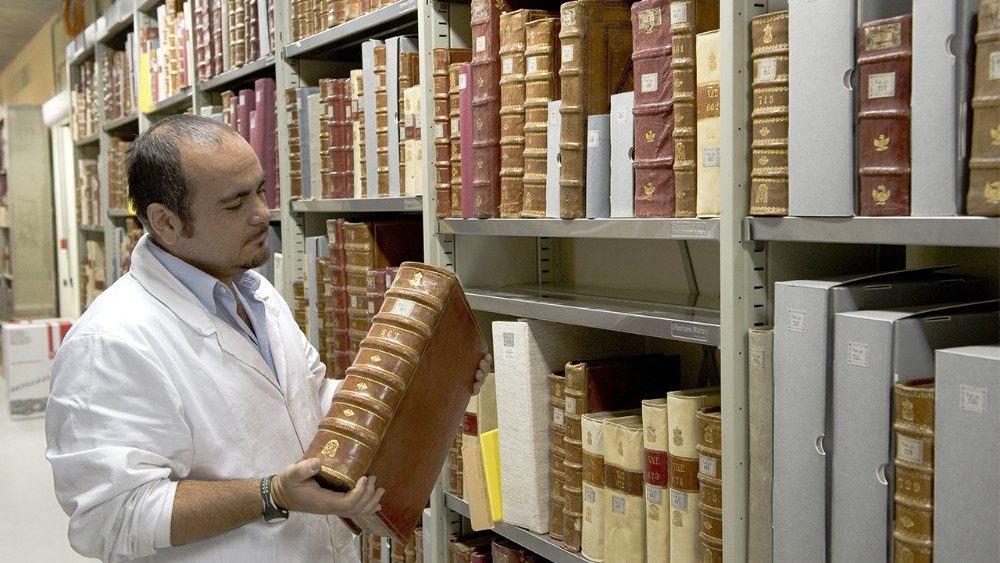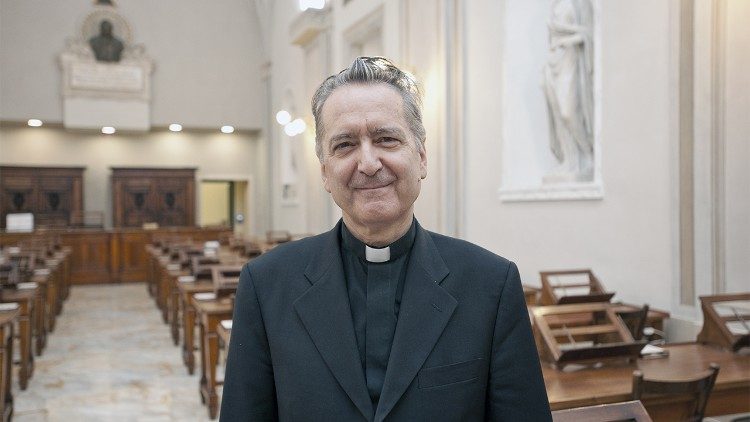At the service of culture and knowledge
by Alessandro De Carolis and Benedetta Capelli – Vatican City
Projected toward the future with same mission as always: to place at the disposition of scholars all the material it houses. The Vatican Apostolic Library is taking this route thanks to a structure that allows it to take care of, conserve and restore, if necessary, the vast patrimony of volumes, engravings and drawings, coins and medals. This patrimony is protected in every way, even through controlling the temperature of the rooms and in the production of high-quality images which are then transferred to its internet site. “Today,” explains Msgr. Cesare Pasini, Prefect of the Vatican Apostolic Library, “20% of all manuscripts are online, about 80 thousand.” This work, or rather this enterprise, will be completed in the next thirty years.
To take care of and protect the patrimony of the Vatican Library requires an historic sensibility and a passion for research, but also particular technical competencies. What type of work is carried out and what type of professionals does the Library employ?
The Library’s employees possess various skills. The Scriptores and all the staff involved with scientific research are dedicated to studying, identifying and cataloguing the manuscripts, and archival documentation. Other members of the staff are specialized and are dedicated to the study, cataloguing and acquisition of printed volumes, engravings and designs, coins and medals – this, therefore, requires specific skills in each of these areas as well as the languages and cultures from which they have been handed down.
The staff working in the restoration laboratory looks after the appropriate conservation of and, when necessary, restoration of material. Personnel working in the photographic laboratory are tasked with the digital photographic reproduction of the material. Both laboratories require specific, constantly updated skills.
Today, the Library includes a broad virtual, digital structure – almost a second virtual library alongside the physical library. It is necessary to provide many services online, through the Library’s website and through digital platforms, primarily granting access to digital images of the manuscripts and other material. A Coordination of IT Services Office is, therefore, necessary as well as a Data Storage Center, with highly-qualified personnel who continually keep themselves up-to-date.
Evidently, a structure such as this requires people with adequate administrative skills within their own field, carried out in particular by the Treasurer’s office, and a series of other services: secretarial offices, promotion and development, admission of scholars, exhibit services through which the Library lends the works it possesses.
Another specialization is required by those who manage and teach in the School of Library Science connected to the Library, who organize bi-annual, post-graduate courses for librarians.
What expenses are associated in taking care of such a vast and precious collection? In what way does the material cost correspond to the mission entrusted to the Library?
The Library’s mission consists in placing the material in its possession at the disposal of scholars. Therefore, the expenses connected with its mission are associated with the work the library does at the service of all those who make use of it and to keep the virtual library updated and accessible to everyone on the internet. In addition, controlling room temperature and the attentive and continual work related to prevention and conservation are necessary to conserve the material properly, all of which has its own corresponding costs. Finally, the Institution’s ordinary costs are attributable to the study and cataloguing of material, and the entire organization of the Library, at the service of its mission.
The technological revolution is also profoundly affecting the ways of reading and transmitting the written word, to the point of questioning the very future of the “book.” What consequences does this have on the structure and activity of the Library?
A Library such as the Vatican’s, both historical and current at the same time, conserves and exploits all the wealth entrusted to it throughout the centuries: the books and everything else are conserved and utilized, studied and researched. Furthermore, as a modern library the Vatican is poised to use all the new tools that promote the knowledge and the communication of this material: its website, information and contact networks, digitization. The Library’s continual challenge is how to better “serve” scholars and all other interested persons, how to communicate and make culture known. News tools are not detaching us from the past, but are a new way to better express the mission and service it always had.
Continuing on the topic of the relationship between tradition and new technologies, at what point is the digitization of the library’s holdings and how will they be accessible to the scholastic community?
Reproductions of manuscripts, engravings and drawings, coins and medals are made accessible through digitization. Continuing the Library’s tradition of welcoming scholars gratuitously, trying to provide them the best service possible, such images are also placed online as they are produced and are freely accessible to everyone. Digitizing the manuscripts, which constitute the major typology of books that have been digitized due to the singular uniqueness of each one, began in 2012, following about two years of careful preparation. Today, the Vatican Library has reproduced and posted online about 20% of all its manuscripts, which total about 80,000. This work is extremely precise so as not to ruin the originals and to produce high-quality images (a work that must not be repeated over the years) and then to facilitate their correct and user-friendly viewing on the Library’s website. We have been able to proceed at a significant pace due to the help of benefactors who have understood the immense value of this enterprise. We expect the project will be complete within the next thirty years.
Thank you for reading our article. You can keep up-to-date by subscribing to our daily newsletter. Just click here










